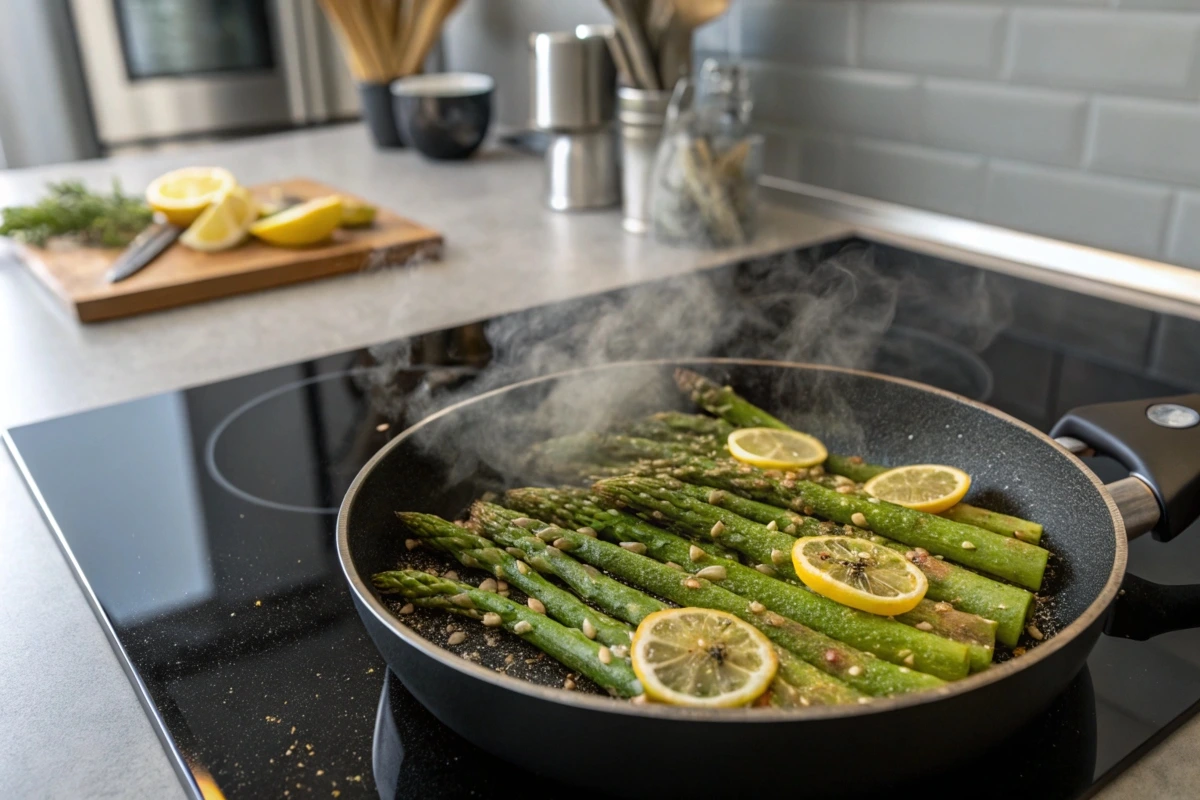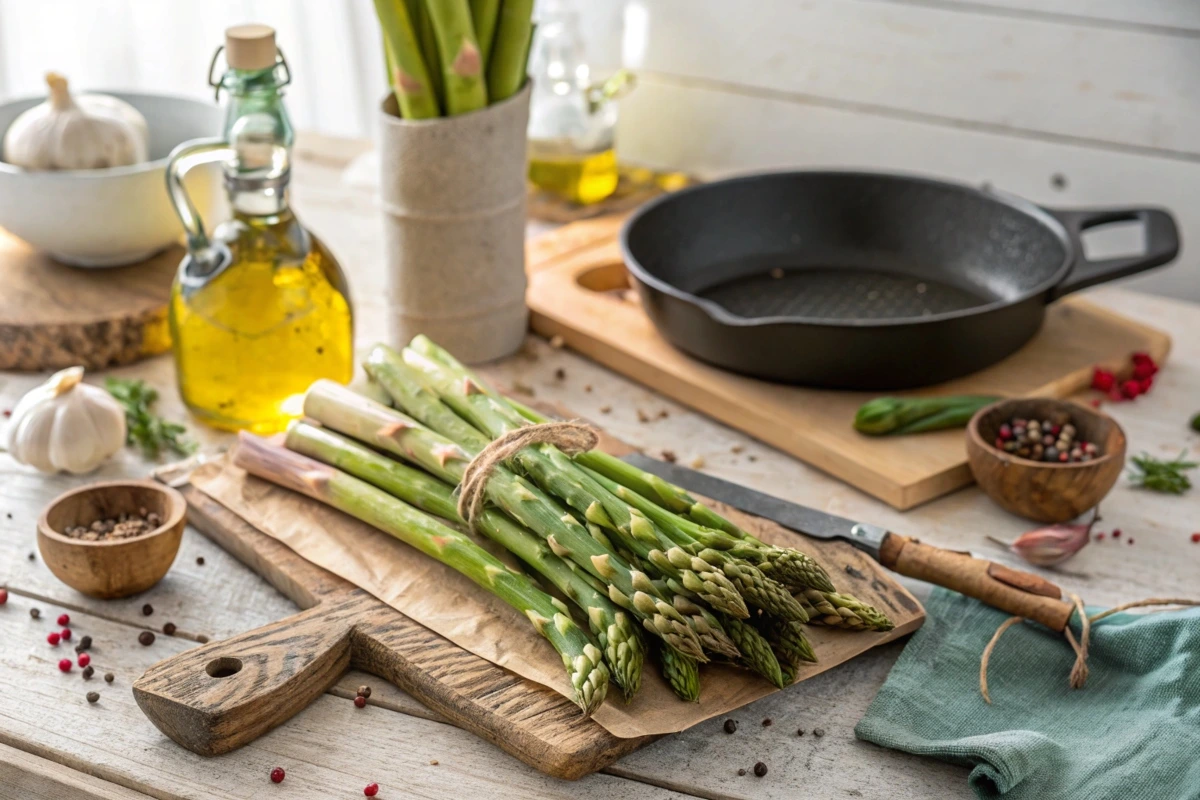Asparagus, with its vibrant green hue and delicate flavor, is a versatile vegetable that graces tables worldwide. From simple weeknight dinners to gourmet feasts, asparagus adapts beautifully to various cooking methods. But which technique truly brings out the best in this tender veggie? This article delves into the most popular ways to cook asparagus, comparing them for taste, nutrition, and convenience. You’ll also discover helpful tips, FAQs, and step-by-step instructions to perfect your asparagus dishes. So, let’s uncover what cooking method is best for asparagus and elevate your culinary game.

Introduction to Asparagus Cooking
The Popularity of Asparagus as a Healthy Side Dish
Asparagus isn’t just delicious, it’s a nutritional powerhouse. Packed with vitamins A, C, E, and K, along with a hefty dose of folate and fiber, it’s a vegetable that earns its spot on any plate. Its unique texture and mildly sweet, grassy flavor make it a favorite among chefs and home cooks alike. Whether served solo or paired with proteins like salmon, steak, or chicken, asparagus adds a touch of elegance to any meal.
Why Cooking Methods Matter for Asparagus Texture and Flavor
When cooked correctly, asparagus is tender yet slightly crisp, with a flavor profile that’s earthy, nutty, and subtly sweet. But overcook it, and you’re left with a limp, soggy disappointment. That’s why choosing the right cooking method is crucial. Different techniques, from roasting to grilling, influence asparagus’s texture, taste, and nutritional value in unique ways. The goal? To enhance its natural flavor while retaining that delightful crunch. In this article, we’ll explore these methods in depth, helping you master the art of asparagus cooking.
Overview of Cooking Methods for Asparagus
Steaming – Retaining Nutritional Value
Steaming asparagus is one of the simplest ways to cook this vegetable while preserving its bright green color and nutrients. By gently cooking it with steam, the asparagus retains its crunch and delicate flavor. This method works wonders for those seeking a low-fat, quick cooking solution. All you need is a steamer basket and a few minutes of prep. However, be cautious not to over-steam; the spears can easily turn mushy.
Boiling – Quick but Risky for Overcooking
Boiling asparagus is a classic technique that’s easy and fast. It involves immersing the spears in hot water for a few minutes. While boiling does soften the stalks quickly, it can strip away some of the nutrients and natural flavor. Additionally, asparagus cooked this way often ends up limp if left in the water for too long. To avoid this, blanch the asparagus briefly and then plunge it into ice water for a crisp texture.
Roasting – Maximizing Flavor
Roasting asparagus in the oven caramelizes its natural sugars, creating a deep, nutty flavor. Tossed with olive oil, salt, and pepper, then baked at a high temperature, roasted asparagus develops crispy tips and a tender interior. This method is ideal for those who enjoy bold flavors and slightly charred edges. Plus, it’s incredibly versatile; you can add garlic, parmesan, or lemon for extra flair.
Sautéing – A Quick and Flavorful Option
Sautéing asparagus is perfect for busy cooks. This method involves cooking the spears in a hot skillet with butter or olive oil. The result? A quick and easy side dish that’s full of flavor and slightly crispy. Sautéing brings out the natural sweetness of asparagus, making it a popular choice for weeknight meals.
Air Frying – Crispy and Convenient
Air frying asparagus is a modern method that delivers crisp-tender spears without much oil. This approach is perfect for achieving a roasted texture in less time. Simply season the asparagus, toss it in the air fryer, and let the magic happen. It’s a great option for those who crave crispy asparagus without using the oven.
Grilling – Adding a Smoky Touch
Grilling asparagus adds a smoky, charred flavor that’s hard to beat. This method works particularly well for outdoor cooking enthusiasts. Brushed with oil and placed over direct heat, asparagus develops grill marks and a slightly chewy texture. It pairs beautifully with summer barbecues or hearty proteins like steak and chicken.
Comparative Analysis of Cooking Methods
Nutritional Impact of Different Methods
When exploring what cooking method is best for asparagus, nutrition often plays a key role. Steaming and air frying top the list for preserving the most vitamins and minerals. Boiling, on the other hand, may lead to nutrient loss, as some vitamins leach into the water. Roasting and grilling enhance the flavor but may reduce certain nutrients due to high heat exposure.
Texture and Flavor Variations Across Methods
Different cooking methods significantly impact asparagus’s texture and flavor. For a crisp-tender bite, steaming and air frying are ideal. Roasting and grilling add layers of caramelized and smoky flavors, perfect for those who love bold tastes. However, sautéing strikes a balance, offering both crispness and a savory edge. Boiling, although fast, risks turning the spears too soft and bland.
Cooking Times and Convenience Factors
Convenience is a deciding factor when choosing how to cook asparagus. Sautéing and steaming are quick methods, perfect for busy weeknights. Air frying and roasting take slightly longer but require minimal supervision. Grilling, while flavorful, demands access to an outdoor setup, making it less practical for everyday meals. Boiling is the fastest but often sacrifices texture.
Cost and Equipment Considerations
Certain methods may require specific tools, such as a steamer basket, air fryer, or grill. Steaming and boiling need minimal equipment, making them budget-friendly options. Roasting and grilling demand an oven or grill, while air frying requires an investment in an air fryer. Understanding your kitchen setup helps determine what cooking method is best for asparagus in your home.
Step-by-Step Guide to Sautéing Asparagus
Ingredients and Preparation
Sautéing asparagus is an effortless way to bring out its natural sweetness and vibrant flavor. To start, you’ll need fresh asparagus spears, olive oil or butter, and simple seasonings like garlic, salt, and pepper. For a gourmet touch, you might add lemon zest, parmesan, or even a pinch of red pepper flakes.
Before cooking, rinse the asparagus thoroughly under cold water and trim the woody ends. If the stalks are particularly thick, consider peeling the lower portion to ensure even cooking. Cut the spears into bite-sized pieces for quicker, more uniform results.
Cooking Process and Key Tips
Heat a skillet over medium heat and add your olive oil or butter. Once hot, toss in the asparagus, spreading the pieces evenly to avoid overcrowding. Stir occasionally, letting the stalks sear slightly for 5-7 minutes until tender yet crisp. Be sure to taste and adjust seasoning during cooking.
Want more flavor? A splash of balsamic vinegar or a sprinkle of parmesan cheese can elevate the dish further. By following these steps, you’ll have a delicious side dish ready in under 10 minutes.
FAQs on Cooking Asparagus
What Cooking Method Is Best for Asparagus?
The answer depends on your preferences. For a crisp-tender texture, sautéing and steaming are top picks. Roasting and grilling add bold, smoky flavors, while air frying offers convenience with minimal cleanup. However, sautéing remains a favorite for its simplicity and quick preparation time.
How Do You Cook Asparagus Without It Getting Soggy?
The key lies in timing and technique. Avoid overcooking by using high heat methods like roasting or grilling. If you’re boiling or steaming, keep the cooking time short and plunge the spears into ice water immediately afterward to lock in their crunch.
Should You Soak Asparagus Before Cooking?
Not necessarily. While a quick rinse removes dirt and grit, soaking is usually unnecessary. Instead, clean the spears thoroughly and pat them dry before cooking to ensure even browning.
Can Frozen Asparagus Be Used, and How Should It Be Cooked?
Yes, but fresh asparagus is ideal for the best flavor and texture. If using frozen, cook it straight from the freezer to prevent sogginess. Methods like air frying or roasting work well for frozen asparagus, delivering a satisfying crunch.
Exploring the Best Flavors of Asparagus
Roasting for a Flavorful Twist
Roasting is a simple yet transformative way to cook asparagus. By tossing the spears with olive oil, salt, and pepper, and roasting them in a hot oven, you can achieve a rich, caramelized flavor that’s both nutty and slightly sweet. This method is perfect when exploring what cooking method is best for asparagus, especially for those who enjoy bold and concentrated flavors. Adding a sprinkle of parmesan cheese or a drizzle of balsamic glaze can take the dish to the next level. For added crunch, try sprinkling breadcrumbs or crushed nuts before roasting.
Adding Zest with Citrus and Herbs
Citrus and herbs bring a refreshing contrast to the natural earthiness of asparagus. Grilled or steamed asparagus pairs beautifully with a squeeze of lemon juice or a sprinkle of orange zest. Toss in some chopped fresh herbs like dill, parsley, or basil to brighten the dish further. For a Mediterranean flair, consider adding a pinch of oregano or thyme.
Enhancing Texture and Flavor
To keep the texture appealing, avoid overcrowding the baking sheet when roasting or oversteaming the spears. Air frying is another excellent option to achieve crisp, golden tips while maintaining the stalks’ tender bite. Seasoning with smoked paprika, garlic powder, or even truffle oil can elevate your asparagus dishes, whether you’re preparing a side for a steak dinner or a light spring salad.
Recipes and Ideas for Asparagus
Pairing Asparagus with Proteins
Asparagus is a versatile vegetable that complements a wide variety of proteins. For a classic pairing, try grilled asparagus alongside a perfectly seared steak, where the smoky flavors of the grill enhance the natural sweetness of the spears. Roasted asparagus also works beautifully with baked salmon, especially when garnished with lemon butter. For poultry lovers, a side of steamed asparagus with herb-seasoned chicken offers a light yet satisfying combination.
Vegetarians can enjoy asparagus paired with hearty grains like quinoa or farro. Toss roasted asparagus into a warm grain salad with goat cheese and dried cranberries for a dish that’s both filling and flavorful.
Creative Asparagus Recipes Beyond Side Dishes
If you’re looking for creative ways to incorporate asparagus into your meals, try blending roasted spears into a creamy soup. This velvety appetizer pairs well with crusty bread for a comforting starter. Alternatively, chop sautéed asparagus and mix it into a spring risotto for a fresh, seasonal dish.
For brunch, asparagus shines in omelets or frittatas. You can also make an asparagus tart by layering puff pastry with ricotta, asparagus spears, and your favorite herbs. When pondering what cooking method is best for asparagus in unique dishes, consider steaming it lightly for salads or roasting it for deeper flavors.
For more asparagus inspiration, check out Asparagus German Recipes for creative twists on this classic vegetable.
Conclusion and Final Tips
Key Takeaways on the Best Cooking Methods
Choosing what cooking method is best for asparagus depends on your preferences for flavor, texture, and time. Steaming preserves its nutrients and crisp-tender bite, while roasting and grilling enhance its natural sweetness with bold flavors. Sautéing offers a quick, fuss-free solution for busy weeknights, and air frying provides a modern, crispy twist with minimal oil. Boiling is the fastest option, though it’s less ideal for retaining flavor and nutrients.
Ultimately, the best method balances your goals, whether it’s a quick preparation or creating a gourmet masterpiece. Each technique has its unique advantages, so don’t hesitate to try them all.
Encouraging Experimentation with Different Techniques
Cooking asparagus is as much about personal taste as it is about technique. If you’re unsure where to start, experiment with sautéing for its simplicity or roasting for its bold flavors. By exploring different methods, you’ll not only master what cooking method is best for asparagus but also discover new ways to elevate this versatile vegetable. Whether paired with proteins, added to pasta, or served as a standalone side, asparagus can transform any meal into something special.
FAQs on Cooking Asparagus
What Makes Asparagus a Versatile Ingredient?
Asparagus adapts beautifully to various cooking styles, allowing for creative culinary exploration. Its mild flavor pairs well with spices, herbs, and sauces, making it a flexible addition to almost any meal. Whether roasted, grilled, or sautéed, it complements proteins, grains, and even other vegetables effortlessly.
How Can You Avoid Overcooking Asparagus?
To prevent soggy asparagus, always keep cooking times short and use high-heat methods like roasting or grilling. If boiling or steaming, transfer the spears to an ice bath immediately to halt cooking. Monitoring the texture closely ensures the spears stay crisp and delicious.
Is Fresh or Frozen Asparagus Better?
While fresh asparagus offers superior flavor and texture, frozen spears are a convenient alternative. To cook frozen asparagus effectively, avoid thawing beforehand and opt for roasting or air frying to retain some crispness.
For More Recipes…
For more asparagus-inspired recipes, don’t miss Asparagus German Recipes on Dakota Recipes. You’ll find plenty of unique ways to enjoy this versatile vegetable!

